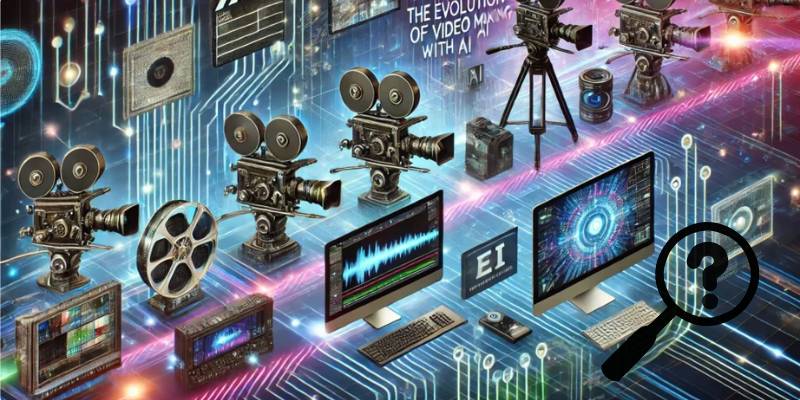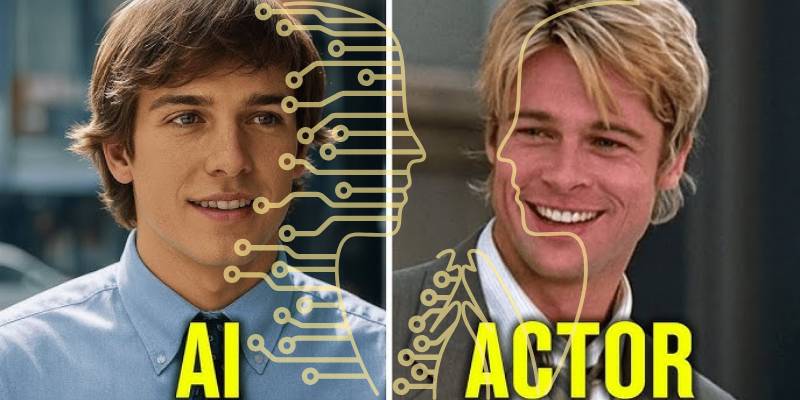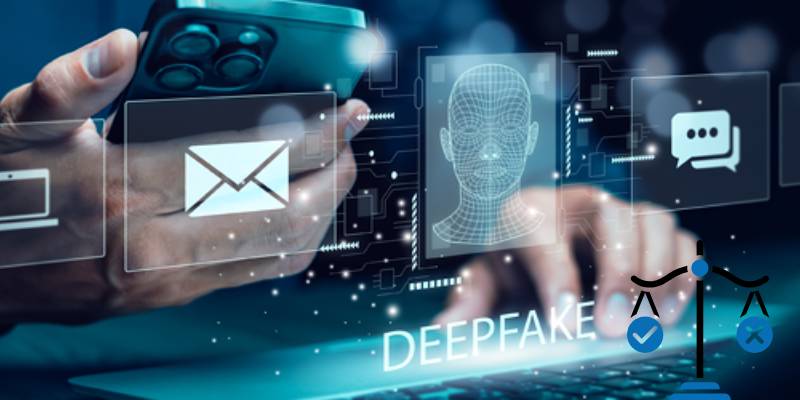If you’ve ever stared at a blank timeline in Adobe Premiere, dreading the hours of cutting, syncing, and color grading ahead, you’ll know exactly why people are turning to AI.
Video is everywhere now—short-form, long-form, vertical, horizontal. Yet the barrier to entry has always been painfully high: time, technical skills, and often, expensive software.
But something has shifted. AI has come crashing into video production in a way that feels both thrilling and, if I’m honest, a little unnerving.
Suddenly, tasks that used to take a team of editors can be done in minutes. Scripts can be drafted, footage generated, sound polished—all without touching a camera.
So, is this the end of traditional video production as we know it? Or is it simply the next stage in a long evolution of storytelling tools? That’s what I want to explore here—not just the “wow” factor of new tech, but the deeper implications: for creators, for businesses, and for us as viewers.
Chapter 1: Why Video Matters More Than Ever
Video isn’t just popular—it’s dominant.
- 91% of businesses use video as a marketing tool (Wyzowl, 2023).
- Viewers retain 95% of a message in video form compared to only 10% through text (Insivia).
- Social media platforms—from TikTok to LinkedIn—prioritize video in algorithms.
This explains why the demand for content is exploding. But the production side hasn’t kept pace—until AI came along.
Chapter 2: The Old Pain Points of Video Production
Let’s not sugarcoat it: video production has historically been slow, expensive, and frustrating.
- Editing: Hours spent splicing clips, syncing audio, and fixing color balance.
- Scripting: Brainstorming, drafting, and revising before the camera even rolls.
- Voiceovers: Hiring narrators or struggling with your own recording setup.
- Accessibility: Subtitles, translations, captions—tedious but necessary.
For small businesses, teachers, nonprofits, or solo creators, these hurdles often made video feel out of reach. That’s why AI feels like such a breakthrough—it directly targets these pain points.
Chapter 3: The Rise of Automated Storytelling
One of the most fascinating applications of AI is automated storytelling. Tools like Runway, Synthesia, and Pictory don’t just edit—they generate.
You can feed them a text prompt, and they’ll create an entire video: script, visuals, narration, even music. It’s like having a production crew in your laptop.
At first, I resisted. Storytelling has always felt deeply human to me, something that requires nuance, emotion, and intuition.
But when I tested a few platforms, I realized: AI doesn’t replace the storyteller—it amplifies them. It removes the grunt work so you can focus on shaping the narrative.
Still, I’ll admit there’s a risk here. If everything becomes too automated, will we lose the raw, imperfect, human edge that makes stories relatable? That’s the tension we’re going to live with.
Chapter 4: Best AI Tools for Creators
If you’re curious about experimenting, here’s a quick overview of some of the best AI tools for creators right now:
| Tool | Best For | Key Features |
| Runway | Editing & generative video | Green screen removal, text-to-video, motion tracking |
| Synthesia | AI avatars & explainer videos | Lifelike avatars reading your script in multiple languages |
| Pictory | Blog-to-video conversion | Automatically generates short videos from text |
| Descript | Audio & video editing | Edit by text transcript, overdubbing voices, podcast-friendly |
| Invideo | Marketing content | Templates, stock footage, AI script generation |
Each of these tools lowers the barrier to video creation. You don’t need to be a Final Cut wizard anymore—you just need to know your message.
Chapter 5: Machine-Made Creativity
Here’s where things get philosophical. Can machines really be creative?
Some argue that “creativity” requires consciousness, intention, and emotion—things AI doesn’t have.
But when I watch a video generated entirely by AI, I can’t deny it feels like machine-made creativity. The visuals might be algorithmically chosen, the script statistically generated, but the result still provokes emotion.
Personally, I think of AI not as a creative replacement but as a collaborator. It can spark ideas I wouldn’t have thought of. Sometimes it suggests imagery or pacing that surprises me—and isn’t surprise part of creativity?
Of course, I’ve also seen outputs that feel soulless, generic, like the uncanny valley of storytelling. That’s the danger of relying too heavily on automation: when the human editor checks out, the result can feel hollow.
Chapter 6: AI in Marketing – The Future of Marketing Videos
Let’s be practical. Where AI is making the biggest waves is in business—specifically, marketing.
The future of marketing videos is already visible:
- Personalized video ads generated at scale.
- Localized campaigns instantly translated into multiple languages.
- Product demos made with avatars instead of expensive shoots.
According to MarketsandMarkets, AI in video analytics is projected to grow from $15.9 billion in 2023 to $53.4 billion by 2028. That’s not hype—that’s investment.
Imagine a small business owner in Chicago generating 100 versions of a video ad—each with personalized text, images, and even voice tone—for different customer segments. What once required an ad agency now takes an afternoon.
It’s efficient, but here’s my worry: will we be drowning in AI-generated ads that all sound the same? Marketing works best when it’s authentic. If AI makes it too easy, brands risk blending into white noise.
Chapter 7: Accessibility and Inclusivity
Another underrated revolution is accessibility. AI can:
- Auto-generate subtitles and captions.
- Translate voiceovers into multiple languages.
- Create versions of content for people with hearing or vision impairments.
This isn’t just a nice-to-have—it’s transformative. Imagine a teacher in the U.S. creating a video lesson instantly available in Spanish, French, or Mandarin. Or a nonprofit spreading a safety message globally without needing a translation budget.
AI is making inclusivity achievable in ways humans alone couldn’t scale. And for me, that’s one of the most exciting, human-centered impacts of this technology.
Chapter 8: The Emotional Nuance Debate
Here’s where I get conflicted. AI can simulate emotion—it can add the right pause in a synthetic voice, the right swell of background music, the perfect cut to a close-up. But does it feel?
The lack of genuine emotional depth is noticeable sometimes. For instance, I’ve heard AI voiceovers that sound convincing but just miss that fragile edge of vulnerability in a human speaker’s tone.
Do audiences notice? Maybe not always. But I think they sense something’s “off.” And that’s why, in my opinion, human creators will always matter. AI can enhance, polish, and scale—but it can’t fully replicate the messy beauty of lived emotion.
Chapter 9: Ethical Questions
AI video production also raises thorny ethical issues:
- Deepfakes: Who’s responsible if AI is used to spread misinformation?
- Labor displacement: What happens to editors, voice actors, and videographers?
- Authenticity: Should creators disclose when a video is AI-generated?
These aren’t abstract concerns. In 2023, deepfake videos of politicians spread rapidly online, prompting questions about regulation and accountability. Without transparency, trust in video as a medium could erode.
My personal stance: transparency is non-negotiable. If a video is AI-generated, say so. The audience deserves to know.
Chapter 10: Practical Use Cases
To ground this in reality, here are some ways AI is already being used in production:
- Corporate training: Avatar-led tutorials instead of costly video shoots.
- Social media content: Quick, polished shorts generated daily.
- Education: Teachers turning lectures into multilingual video explainers.
- Entertainment: Indie creators experimenting with AI-generated visuals.
- Healthcare: Instructional videos for patients, automatically subtitled.
These aren’t hypothetical—they’re happening. And they’re making video creation accessible to people who were locked out before.
Chapter 11: Where Do We Go From Here?
The revolution isn’t stopping. We’re heading toward:
- Fully interactive AI videos that adapt in real time to viewer input.
- Hyper-personalized video experiences at scale.
- Seamless blending of human and AI production workflows.
And maybe most intriguingly: a cultural shift in how we define “authentic” video. Will authenticity mean “human-made,” or simply “effective”?
I think we’ll see a mix. Some audiences will crave raw, human imperfection. Others will embrace the polish of AI-generated content. The ecosystem will expand rather than collapse into one style.
Conclusion
AI is revolutionizing video production. From automated storytelling to machine-made creativity, from inclusivity to the future of marketing videos, the impact is undeniable.
But revolution always comes with tension. Will AI democratize video or flood us with generic content? Will it empower creators or displace them? Will audiences value transparency or just results?
My opinion? AI is here to stay, and resisting it misses the point. The challenge isn’t whether to use it—it’s how to use it responsibly.
As creators, we should embrace AI for the heavy lifting while holding tight to the human elements—authenticity, vulnerability, nuance—that no machine can fully replace.
Because at the end of the day, video isn’t just pixels on a screen. It’s a medium for connection. And connection is still, stubbornly, beautifully human.


